
The chupacabra is a creature said to inhabit parts of the Latin America, associated particularly with Puerto Rico, where it was first reported, Mexico, Chile, Brazil and the United States, especially in the latter's Latin American communities. Other reports have also noted the Chupacabra in regions throughout North America, from Miami to Maine. Perhaps this creature has been confused with other possible cryptids and summed up into just one term.
The name translates in Portuguese and Spanish litteraly as "goat-sucker". This name comes from the creature's reported habit of attacking and drinking the blood of livestock, especially goats. Sightings began in Puerto Rico in the early 1990s, and have since been reported as far north as Maine, and as far south as Chile. Though some argue that the chupacabras may be real creatures, mainstream scientists and experts generally contend that the chupacabra is a legendary creature, or a type of urban legend.  The legend of El Chupacabra began in 1947, when Puerto Rican newspapers El Vocero and El Nuevo Dia began reporting that local farmers livestock where being killed, such as birds, horses, and as its name implies, goats. While at first it was suspected that the killings were done randomly by some members of a Satanic cult, eventually these killings spread around the island, hundreds of farms reported loss of animal life. These strange killings had one pattern in common, each of the animals found dead had two punctured holes around its neck.
The legend of El Chupacabra began in 1947, when Puerto Rican newspapers El Vocero and El Nuevo Dia began reporting that local farmers livestock where being killed, such as birds, horses, and as its name implies, goats. While at first it was suspected that the killings were done randomly by some members of a Satanic cult, eventually these killings spread around the island, hundreds of farms reported loss of animal life. These strange killings had one pattern in common, each of the animals found dead had two punctured holes around its neck.
Soon after the animal deaths in Puerto Rico, other animal deaths were reported in other countries, such as the Dominican Republic, Argentina, Bolivia, Chile, Colombia, Honduras, El Salvador, Panama, Peru, Brazil, the United States and, most notably, Mexico. Both in Puerto Rico and Mexico, "El Chupacabra" gained urban legend status, Chupacabra stories began to be released in American and Hispanic newscasts across the United States, and Chupacabra merchandise, such as T-shirts and baseball caps, were sold.
The Chupacabra is generally treated as a product of mass hysteria, though the animal mutilations are sometimes real. 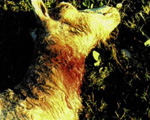 Like many cases of such mutilations, however, it has been argued that they are often not as mysterious as they might first appear, and in fact, a series of tests showcased by the National Geographic Channel in a show about the Chupacabra pointed to the obvious conclusion that every single "animal mutilation" can be explained by either people killing them or, more likely, other animals eating them.
Like many cases of such mutilations, however, it has been argued that they are often not as mysterious as they might first appear, and in fact, a series of tests showcased by the National Geographic Channel in a show about the Chupacabra pointed to the obvious conclusion that every single "animal mutilation" can be explained by either people killing them or, more likely, other animals eating them.
The loss of blood may be explained by insects drinking it. Certain South American rain forest natives believe in the "mosquito man", a mythical creature of their folklore that pre-dates modern Chupacabra sightings. The Mosquito-Man sucks the blood from animals through his long nose, like a big mosquito. Some say mosquito-man and the chupacabra are one and the same.
One story states that in September of 2006, a hotel employee named Valerie Pauls of Albuquerque, New Mexico was startled by a hissing noise upon arriving for work at about 7:00 in the morning. She glanced up to the sixth floor roof of the Amerisuites Hotel. She saw two glowing red eyes peering down upon her. The creature resembled a gargoyle, and smelled of sulphur. The creature terrified Ms. Pauls as it continued hissing and flashing neon colors. 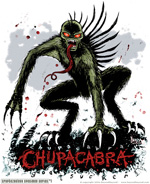 She became dizzy and disoriented. She managed to return to her vehicle as the alleged Chupacabra descended upon her vehicle. The creature broke the windshield before leaping back up unto the roof of the hotel and vanishing. Notable sightings in the United States include one reported by multiple eye-witnesses in Calaveras County, California, and at a recent birthday celebration of a Development Team member of a local charity in Houston, Texas.
She became dizzy and disoriented. She managed to return to her vehicle as the alleged Chupacabra descended upon her vehicle. The creature broke the windshield before leaping back up unto the roof of the hotel and vanishing. Notable sightings in the United States include one reported by multiple eye-witnesses in Calaveras County, California, and at a recent birthday celebration of a Development Team member of a local charity in Houston, Texas.
In July 2004, a rancher near San Antonio, Texas, killed a hairless, dog-like creature which was attacking his livestock. This creature is now known as the Elmendorf Creature. It was later determined to be a canine of some sort, most likely a coyote, with demodectic mange. In October 2004, two animals which closely resemble the Elmendorf Creature were observed in the same area. The first was dead, and a local zoologist who was called to identify the animal noticed the second while she was travelling to the location where the first was found. Specimens were studied by biologists in Texas. The creatures are thought to have been canines of undetermined species with skin problems and facial deformities. 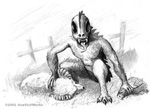 In 2005, Isaac Espinoza reportatly spent close to $6 million of his own money trying to track down the Chupacabra. He lived in the jungles of South America for eight months with a team of researchers, video and print journalists and local guides. During the course of the expedition the team had several close encounters with a creature that the researchers were not able to identify. The team was able to capture several of their encounters with the creature on film and it has all been turned over to the University of Texas for analysis. Hugo Mata, a professor of cryptozoology at the University of Texas, has said the hair and skin samples submitted by the team do not match any known species for that part of the world.
In 2005, Isaac Espinoza reportatly spent close to $6 million of his own money trying to track down the Chupacabra. He lived in the jungles of South America for eight months with a team of researchers, video and print journalists and local guides. During the course of the expedition the team had several close encounters with a creature that the researchers were not able to identify. The team was able to capture several of their encounters with the creature on film and it has all been turned over to the University of Texas for analysis. Hugo Mata, a professor of cryptozoology at the University of Texas, has said the hair and skin samples submitted by the team do not match any known species for that part of the world.
In Albuquerque, New Mexico, A 42 year old woman, Rebecca Tuggle, was on the way to her car when she heard a mysterious hissing noise. As she turned around she was terrified to see a creature partially resembling a lizard, a kangaroo, and a bat, with "rainbow-colored" spines running down its back. The creature stood 3 to 4 feet tall and grunted at her. The creature's hissing noise nauseated her and she nearly fainted. As with other sightings, the eyes were said to glow red and the animal smelled of a sulfuric substance. The Chupacabra has often been spotted in Michigan. A recent un confirmed sighting occurred in Grand Haven, when a 42-year-old man claimed he saw it suck the blood out of a cat.
A famous appearance in the city of Varginha, Brazil, known as the "Varginha incident", is sometimes attributed to the Chupacabra, although cryptozoologists more frequently associate the incident with extraterrestrials. In 1997, an explosion of Chupacabra sightings in Brazil where reported in Brazilian newspapers. One report came from a police officer, who claimed to get a nauseous feeling when he saw a dog-like chupacabra in a tree. Recently, there has been a surge of Chupacabra sightings in the United States, specifically in the suburbs of Washington, D.C., and outside of the Philadelphia, Pennsylvania area. However, controversy exists whether these chupacabra sightings are legitimate.
In Coleman, Texas, a farmer named Reggie Lagow caught an unknown animal in a trap he set up after the deaths of a number of his chickens and turkeys. The animal appeared to be a mix between a hairless dog, a rat and a kangaroo. The mystery animal was reported to Texas Parks and Wildlife in hopes of determining what it was, but Lagow said in a September 17th, 2006, phone interview with John Adolfi, founder of the Lost World Museum, that the "critter was caught on a Tuesday and thrown out in Thursday's trash."
In Septemeber of 2006, in High Rolls, New Mexico, near Alamogordo, A roper Trey Rogers spotted what he believed was the El Chupacabra. He was out in the forest with his paint ball gun looking for game when he spotted a medium sized brown redish-animal that had spikes down its back and wings on its side. Before Trey could get a shot it took off at the speed or fastest than the quickest rabbit. It was the fastest thing Trey had ever seen.
In April of 2006, MosNews reported that the chupacabra was spotted in Russia for the first time. Reports from Central Russia beginning in March 2005 tell of a beast that kills animals and sucks out their blood. Thirty-two turkeys were killed and drained overnight. Reports later came from neighboring villages when 30 sheep were killed and had their blood drained. Finally eyewitnesses were able to describe the Chupacabra. 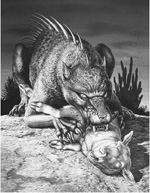 In mid-August 2006, Michelle O'Donnell of Turner, Maine, described an "evil looking" dog-like creature with fangs found along side a road, apparently struck by a car, but it was otherwise unidentifiable. Photographs were taken and several witness reports seem to be in relative agreement that the creature was canine in appearance, but unlike any dog or wolf in the area. The carcass was picked clean by vultures before experts could examine it. For years, residents of Maine have reported a mysterious creature and a string of dog maulings.
In mid-August 2006, Michelle O'Donnell of Turner, Maine, described an "evil looking" dog-like creature with fangs found along side a road, apparently struck by a car, but it was otherwise unidentifiable. Photographs were taken and several witness reports seem to be in relative agreement that the creature was canine in appearance, but unlike any dog or wolf in the area. The carcass was picked clean by vultures before experts could examine it. For years, residents of Maine have reported a mysterious creature and a string of dog maulings.
On September 2006, the Lost World Museum acquired the remains of what may be a Chupacabra. Spotted, hunted and killed in late August 2006, 15 yr. old Geordie Decker and 16 yr. old Josh Underwood of Berkshire, New York handed over the bones of a small fox like beast that hopped, had yellow eyes and an orange strip of hair going down its almost bald gray back, to Museum owner John Adolfi.
Its bones are currently on display on the Lost World Museum's web site while further examination and investigation continues.
Stacey Womack, dog breeder and former veterinarian tech assistant, Lufkin, Texas: "My mother was just sort of hysterical because they had killed something under the house and they did not know what it was. I thought, 'This is the most ridiculous thing I've ever heard.'
They don't know whether it's a coyote or a dog?! I told my mother I would come out there and bring my digital camera. About one-quarter mile from my mother's house, I had to hit my breaks because an animal crossed the road in front of me and it was running with its head down and its tail down and it did not have any hair. It was a strange looking sight and my daughter-in-law was with me and she wanted to know if it was a wolf.
I told her it wasn't a wolf and it was too large for a fox. So, we went on to my mother's house and went around to the back and there was the same animal an animal identical to what ran across the road. It was on the ground after they had just killed it and there was almost no blood. It was just red where the shot had went in (the eye). I was just totally dumbfounded when I saw it. At first glance, you would think of a deer's head on a kangaroo's body. The ears were real thick and large. It did not have any hair on it. The skin tissue was necrotic. It was just awful. I did not know what it was."
Descriptions of the physical appearance of each specimen can resemble descriptions of other reports, or be completely different from other Chupacabra descriptions. Differences in descriptions are too wide to be attributed to differences in the perceptions of the observers, causing cryptozoologists to speculate that Chupacabra reports may in fact be attributable to several species. Although they have different appearances, Chupacabra descriptions have several common traits. The following 3 discriptions of the Chupacabra are the most commonly reported:
The first and most common form is a lizard-like being, appearing to have leathery or scaly greenish-gray skin and sharp spines or quills running down its back. This form stands approximately 3 to 4 feet high, and stands and hops in a similar fashion to a kangaroo. In at least one sighting, the creature hopped 20 feet. This variety is said to have a dog or panther-like nose and face, a forked tongue protruding from it, large fangs, and to hiss and screech when alarmed, as well as leave a sulfuric stench behind. When it screeches, some reports note that the Chupacabra's eyes glow an unusual red, then give the witnesses nausea.
The second variety bears a resemblance to a wallaby or dog standing on its hind legs. It stands and hops as a kangaroo, and it has coarse fur with greyish facial hair. The head is similar to a dog's, and its mouth has large teeth.
The third form is described as a strange breed of wild dog. This form is mostly hairless, has a pronounced spinal ridge, unusually pronounced eye sockets, teeth, and claws. This animal is said to be the result of interbreeding between several populations of wild dogs, though enthusiasts claim that it might be an example of a dog-like reptile. The account during the year 2001 in Nicaragua of a chupacabra's corpse being found supports the conclusion that it is simply a strange breed of wild dog.
The alleged corpse of the animal was found in Tolapa, Nicaragua, and forensically analyzed at UNAN-Leon. Pathologists at the University found that it was just an unusual-looking dog. There are very striking morphological differences between different breeds of dog, which can easily account for the strange characteristics. 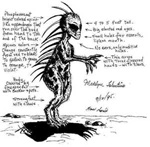 Some reports claim the Chupacabra's red eyes have the ability to hypnotize and paralyze their prey, leaving the prey animal mentally stunned, allowing the chupacabra to suck the animal's blood at its leisure. The effect is similar to the bite of the vampire bat, or of certain snakes or spiders that stun their prey with venom. Unlike conventional predators, the Chupacabras sucks all the animal's blood, and sometimes organs, through a single hole or two holes in the creatures neck.
Some reports claim the Chupacabra's red eyes have the ability to hypnotize and paralyze their prey, leaving the prey animal mentally stunned, allowing the chupacabra to suck the animal's blood at its leisure. The effect is similar to the bite of the vampire bat, or of certain snakes or spiders that stun their prey with venom. Unlike conventional predators, the Chupacabras sucks all the animal's blood, and sometimes organs, through a single hole or two holes in the creatures neck.
Many residents of South America have reported sightings of El Chupacabras, and although various, the descriptions share some significant likenesses. In many reports, accounts include the visible inflation of the stomach region, after El Chupacabra has been feeding. The appearance of the animal changes when an internal bladder-like organ fills with the blood of its prey. Furthermore, with almost all the reported sightings witnesses have reported large protruding fangs. These fangs are suspected to be hollow and be the vehicles for the blood on which it feeds.
Chupacabras have been described as similar in appearance to gargoyles, so it has been theorized that the creatures were seen in Medieval Europe. According to this theory, gargoyles were carved to resemble Chupacabras, to keep the public, and sometimes believed to keep evil spirits, afraid of any place with gargoyles.
Some cryptozoologists speculate that chupacabras are alien creatures.
Chupacabras are widely described as otherworldly, and, according to one witness report, NASA may be involved with this particular alien's residency on earth. The witness reported that NASA passed through an area in Latin America, with a trailer that was thought to contain an incarcerated creature. There have also been UFOs seen where Chupacabras have been at the same time on occasion. Others speculate that the creature is an escaped pet of alien visitors that wandered off while its master was visiting Earth. The Chupacabra does have a slight resemblance to the Greys, a form of alien said to visit earth, which could mean that they are somehow related. 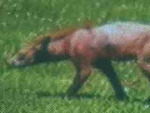 Some people in the island of Puerto Rico believe that the Chupacabras were a genetic experiment from some United States' government agency, which escaped from a secret laboratory in El Yunque, a mountain in the east part of the island when the laboratory was damaged during a severe storm in the early 1990s. The US military have had a large presence across Puerto Rico since the 1930s, with bases on the island used as Research and Development facilities, amongst other things, up to the present day.
Some people in the island of Puerto Rico believe that the Chupacabras were a genetic experiment from some United States' government agency, which escaped from a secret laboratory in El Yunque, a mountain in the east part of the island when the laboratory was damaged during a severe storm in the early 1990s. The US military have had a large presence across Puerto Rico since the 1930s, with bases on the island used as Research and Development facilities, amongst other things, up to the present day.
The lethal agent orange chemicals were tested by the US on the crops of Puerto Rico in widespread crop-spraying operations, all performed without notifying local people or farmers, and the efficacy and safety of contraceptive medicines was also secretly tested on islanders who had no knowledge of their 'guinea pig' status at all.
Another possibility would involve giant vampire bats of which a few fossils have been found in South-America. An alternative explanation is that the creatures are not real at all, and the sightings are either a product of superstition and imagination, or simply other animals that have been wrongly identified. There is only one thing we know for sure about El Chupacabra, that is that we know nothing about what the creature might actualy be.
The Evidence
Evidence of El Chupacabra is limited to numberous sightings and strange, canine like, carcasses. Sightings of the Chupacabra have been reported all over the world, from Russia to Maine to Pueto Rico, corpses of unidentified canine like creatures have also been discuved in area’s the Chupacabra have been spoded. These bodies are normaly atributed to sickly coyoties with severe cases of mange. Several photo’s of the alleged creature have surfaced however most have been disproven as hoaxes.
The Sightings
Hundreds, if not thousands of Chupacabra sightings or creatures described like one of the three versions of the beast have been reported world wide. This creature seems to be on the rise as far as sightings are concerned and seems to be spreading globally. Below are just a handful of the well documented accounts that were reported.
In Albuquerque, New Mexico, A 42 year old woman (Rebecca Tuggle) was on the way to her car when she heard a mysterious hissing noise. As she turned around she was terrified to see a creature partially resembling a lizard, a kangaroo, and a bat, with "rainbow-colored" spines running down its back. The creature stood 3-4' tall and grunted at her. The creature's hissing noise nauseated her and she nearly fainted. As with other sightings, the eyes were said to glow red and the animal smelled of a sulfuric substance
The chupacabra has often been spotted in Michigan. A recent sighting occurred in Grand Haven, when a 42-year-old man claimed he saw it suck the blood out of a cat.
In the fall of 1996 our founder, Jay Correia, had a vivid close encounter with a creature he believes is a Chupacabra or version of it in a cemetery behind his house after clearing through some woods. The encounter lasted roughly 30-45 seconds when a kangaroo like creature with the face of a dog which had course short fur was seen going through a trash heap. The creature turned, snarled, looked directly at him, and then wobble hopped its way into the forest and seemingly vanished. To read the full story Click Here.
In 1997, an explosion of chupacabra sightings in Brazil was reported in Brazilian newspapers. One report came from a police officer, who claimed to get a nauseous feeling when he saw a dog-like chupacabra in a tree. Recently, there has been a surge of chupacabra sightings in the United States, specifically in the suburbs of Washington, D.C., and outside of the Philadelphia, Pennsylvania area.
July 2004, a rancher near San Antonio, Texas, killed a hairless, dog-like creature which was attacking his livestock. This creature is now known as the Elmendorf Creature. It was later determined to be a canine of some sort, most likely a coyote, with demodectic mange.
October 2004, two animals which closely resemble the Elmendorf Creature were observed in the same area. The first was dead, and a local zoologist who was called to identify the animal noticed the second while she was travelling to the location where the first was found. Specimens were studied by biologists in Texas. The creatures are thought to have been canines of undetermined species with skin problems and facial deformities.
2005, Isaac Espinoza reportatly spent close to $6 million of his own money trying to track down the chupacabra. He lived in the jungles of South America for eight months with a team of researchers, video and print journalists and local guides. During the course of the expedition the team had several close encounters with a creature that the researchers were not able to identify. The team was able to capture several of their encounters with the creature on film and it has all been turned over to the University of Texas for analysis.
September 17th, 2006, In Coleman, Texas, a farmer named Reggie Lagow caught an unknown animal in a trap he set up after the deaths of a number of his chickens and turkeys. The animal appeared to be a mix between a hairless dog, a rat and a kangaroo. The mystery animal was reported to be to Texas Parks and Wildlife in hopes of determining what it was.
Septemeber of 2006, in High Rolls, New Mexico, near Alamogordo, A roper Trey Rogers spotted what he believed was the El Chupacabra. He was out in the forest with his paint ball gun looking for game when he spotted a medium sized brown redish-animal that had spikes down its back and wings on its side. Before Trey could get a shot it took off at the speed or fastest than the quickest rabbit. It was the fastest thing Trey had ever seen.
September of 2006, a hotel employee named Valerie Pauls of Albuquerque, New Mexico was startled by a hissing noise upon arriving for work at about 7:00 in the morning. She glanced up to the sixth floor roof of the Amerisuites Hotel. She saw two glowing red eyes peering down upon her. The creature resembled a gargoyle, and smelled of sulphur. The creature terrified Ms. Pauls as it continued hissing and flashing neon colors. She became dizzy and disoriented. She managed to return to her vehicle as the alleged Chupacabra descended upon her vehicle. The creature broke the windshield before leaping back up unto the roof of the hotel and vanishing.
April of 2006, MosNews reported that the chupacabra was spotted in Russia for the first time. Reports from Central Russia beginning in March 2005 tell of a beast that kills animals and sucks out their blood. Thirty-two turkeys were killed and drained overnight. Reports later came from neighboring villages when 30 sheep were killed and had their blood drained. Finally eyewitnesses were able to describe the chupacabra.
August 2006, Michelle O'Donnell of Turner, Maine, described an "evil looking" dog-like creature with fangs found along side a road, apparently struck by a car, but it was otherwise unidentifiable.
September 2006, the Lost World Museum acquired the remains of what may be a Chupacabra. Spotted, hunted and killed in late August 2006, 15 yr. old Geordie Decker and 16 yr. old Josh Underwood of Berkshire, New York handed over the bones of a small fox like beast that hopped, had yellow eyes and an orange strip of hair going down its almost bald gray back, to Museum owner John Adolfi. Its bones are currently on display on the Lost World Museum's web site while further examination and investigation continues.
Spring 2007, a series of supposed chupacabra sightings popped up in remote villages in the South American country of Chilie. Hundreds of sightings are now reported annually.
The Stats – (Where applicable)
• Classification: Unknown / Hybrid
• Size:3 – 5 Feet Tall
• Weight: Unknown (estimated 65-130lbs)
• Diet: The Blood of Small Animals and Livestock
• Location: World Wide
• Movement: Walking and in some cases Flying
• Environment: Wooded Area’s surrounding farm land
|